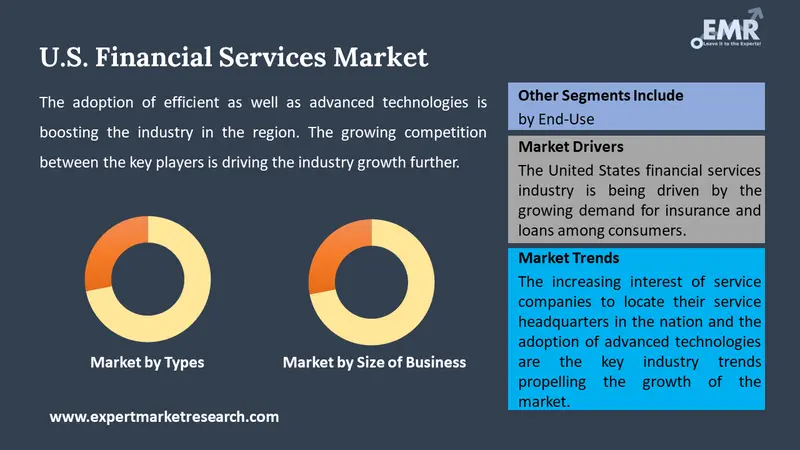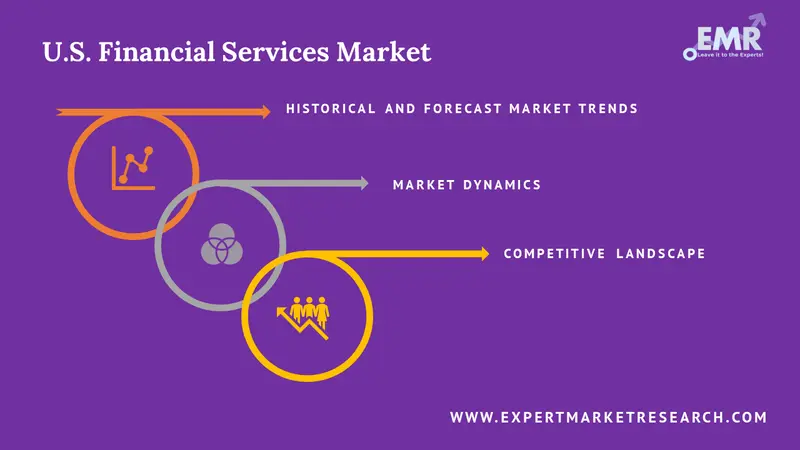
Consumer Insights
Uncover trends and behaviors shaping consumer choices today
Procurement Insights
Optimize your sourcing strategy with key market data
Industry Stats
Stay ahead with the latest trends and market analysis.
The United States financial services market size attained a value of USD 65.18 Billion in 2025. The market is expected to grow at a CAGR of 7.47% between 2026 and 2035, reaching almost USD 133.96 Billion by 2035.
Base Year
Historical Period
Forecast Period
Compound Annual Growth Rate
7.47%
Value in USD Billion
2026-2035
*this image is indicative*
The global financial services industry is expected to grow at a CAGR of around 6% in the forecast period of 2026-2035, owing to the increasing demand for cheaper loans and other financial services. The market in the United States is aided by the finance planning and advice market in the region, which reached a value of nearly USD 57 billion in 2020.
The United States has the largest and most liquid financial markets globally. The finance and insurance market alone represented nearly 7.5% of the nation’s gross domestic product in 2018. On the other hand, the financial services and insurance sector employed around 6.4 million people by the end of 2018. The United States is the place where the market for venture capital began for the first time. The region continues to be supportive of most of the innovative companies. The venture capital-based companies employ almost 40% of the working population. Thus, the financial services industry has been thriving in the United States.
In 2018, the banking sector supported the region’s economy, which is one of the largest economies in the world. The sector provides the region with great diversity in terms of banking, as well as the concentration of its private credit all over the world.
Financial services refer to the mechanism by which a customer or company obtains a financial good. It is a sector that is increasingly influential in the modern economy. They apply to a wide range of more specific activities, such as banking savings as well as insurance. They are limited to the activities of financial services firms and their professionals, while financial products refer to the actual goods, accounts, or investments they provide.
Based on type, the market is divided into:
On the basis of size of business, the market is bifurcated into:
Based on end-use, the market is segmented into:
Market Breakup by Region:

Read more about this report - REQUEST FREE SAMPLE COPY IN PDF
The United States financial services industry is being driven by the growing demand for insurance and loans among consumers. Globalisation and urbanisation are leading to the increasing demand in the end-user investments. The industry is also being propelled by the global economic growth, which is leading to the increased demand for financial services. The increasing disposable incomes of the consumers is enabling them to invest more, thus propelling the financial services industry further.
The financial services industry in the United States is also being supported by the increased demand for cheaper loans since the demand for housing, and other amenities is growing among the consumers. The services are also being demanded for the start-up businesses. The adoption of efficient as well as advanced technologies is boosting the industry in the region. The growing competition between the key players is driving the industry growth further.
The United States financial services industry is also being driven by the increasing interest of service companies to locate their service headquarters in the nation. It would be beneficial to the service providers as they would be able to benefit from the creative, competitive, as well as the comprehensive financial services industry of the United States.

Read more about this report - REQUEST FREE SAMPLE COPY IN PDF
Key United States financial services market players are actively investing in digital platforms to improve mobile payments, online banking, and personalised financial services. Financial services companies in the United States are also incorporating ESG into their investment products, strategies, and solutions to capitalise on the growing trend of sustainability.
JPMorgan Chase & Co., headquartered in New York, United States, is one of the world's largest and oldest financial institutions. With its history dating back to 1799, the company is a leader in financial services, investment banking, financial transaction processing, commercial banking, and asset management. As of September 30th 2024, the company boasted USD 4.2 trillion in assets and USD 346 billion in stockholders’ equity.
Bank of America Corporation, headquartered in North Carolina, United States, and established in 1904, is one of the world's largest financial institutions. It offers investment, banking, and asset management, among other financial and risk management products and services to serve large corporations, businesses, and individuals. Its services and products are used by nearly 56 million consumer and small business relationships in the United States.
Citigroup, Inc., headquartered in New York, United States, and established in 1812, is one of the world’s largest financial service providers. Its core competencies include lending money, safeguarding assets, accessing capital markets on behalf of clients, and making payments. The company boasts financial flows of nearly USD 5 trillion.
Wells Fargo & Company, established in 1852 and headquartered in California, United States, is a community-based and diversified financial services company. Offering consumer and commercial finance and banking, investment and mortgage products and services, it boasts nearly USD 1.9 trillion in assets. The company employs around 250,000 individuals and serves every 1 in 3 households in the United States.
*Please note that this is only a partial list; the complete list of key players is available in the full report. Additionally, the list of key players can be customized to better suit your needs.*
Other leading companies in the United States financial services market include U.S. Bancorp, The Goldman Sachs Group Inc., TD Bank, N.A., MetLife, Inc, Edward Jones Investments, Nationwide Mutual Insurance Company, Farmers Insurance Group, and Capital One Financial Corporation, among others.
United Kingdom Financial Services Market




*While we strive to always give you current and accurate information, the numbers depicted on the website are indicative and may differ from the actual numbers in the main report. At Expert Market Research, we aim to bring you the latest insights and trends in the market. Using our analyses and forecasts, stakeholders can understand the market dynamics, navigate challenges, and capitalize on opportunities to make data-driven strategic decisions.*
Get in touch with us for a customized solution tailored to your unique requirements and save upto 35%!
The United States financial services market reached a value of nearly USD 65.18 Billion in 2025.
The United States financial services market is projected to grow at a CAGR of 7.47% between 2026 and 2035.
The major drivers of the market include the growing demand for insurance and loans, global economic growth and increasing number of start-up businesses.
The increasing interest of service companies to locate their service headquarters in the nation and the adoption of advanced technologies are the key industry trends propelling the growth of the market.
Banking is the dominant type of financial service in the United States financial services market.
The major end-uses of the financial services market in the United States include the Business-to-Business (B2B) and Business-to-Consumer (B2C).
The major players in the industry are JPMorgan Chase & Co., Bank of America Corporation, Citigroup, Inc., Wells Fargo & Company, U.S. Bancorp, The Goldman Sachs Group Inc., TD Bank, N.A., MetLife, Inc, Edward Jones Investments, Nationwide Mutual Insurance Company, Farmers Insurance Group, and Capital One Financial Corporation, among others.
The market is estimated to witness a healthy growth in the forecast period of 2026-2035 to reach a value of USD 133.96 Billion by 2035.
Explore our key highlights of the report and gain a concise overview of key findings, trends, and actionable insights that will empower your strategic decisions.
| REPORT FEATURES | DETAILS |
| Base Year | 2025 |
| Historical Period | 2019-2025 |
| Forecast Period | 2026-2035 |
| Scope of the Report |
Historical and Forecast Trends, Industry Drivers and Constraints, Historical and Forecast Market Analysis by Segment:
|
| Breakup by Type |
|
| Breakup by Size of Business |
|
| Breakup by End-Use |
|
| Breakup by Region |
|
| Market Dynamics |
|
| Competitive Landscape |
|
| Companies Covered |
|
Datasheet
One User
USD 2,499
USD 2,249
tax inclusive*
Single User License
One User
USD 3,999
USD 3,599
tax inclusive*
Five User License
Five User
USD 4,999
USD 4,249
tax inclusive*
Corporate License
Unlimited Users
USD 5,999
USD 5,099
tax inclusive*
*Please note that the prices mentioned below are starting prices for each bundle type. Kindly contact our team for further details.*
Flash Bundle
Small Business Bundle
Growth Bundle
Enterprise Bundle
*Please note that the prices mentioned below are starting prices for each bundle type. Kindly contact our team for further details.*
Flash Bundle
Number of Reports: 3
20%
tax inclusive*
Small Business Bundle
Number of Reports: 5
25%
tax inclusive*
Growth Bundle
Number of Reports: 8
30%
tax inclusive*
Enterprise Bundle
Number of Reports: 10
35%
tax inclusive*
How To Order

Select License Type
Choose the right license for your needs and access rights.

Click on ‘Buy Now’
Add the report to your cart with one click and proceed to register.

Select Mode of Payment
Choose a payment option for a secure checkout. You will be redirected accordingly.
Gain insights to stay ahead and seize opportunities.

Get insights & trends for a competitive edge.

Track prices with detailed trend reports.

Analyse trade data for supply chain insights.

Leverage cost reports for smart savings

Enhance supply chain with partnerships.

Connect For More Information
Our expert team of analysts will offer full support and resolve any queries regarding the report, before and after the purchase.
Our expert team of analysts will offer full support and resolve any queries regarding the report, before and after the purchase.
We employ meticulous research methods, blending advanced analytics and expert insights to deliver accurate, actionable industry intelligence, staying ahead of competitors.
Our skilled analysts offer unparalleled competitive advantage with detailed insights on current and emerging markets, ensuring your strategic edge.
We offer an in-depth yet simplified presentation of industry insights and analysis to meet your specific requirements effectively.
Share